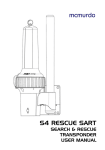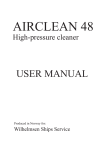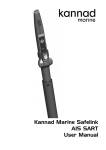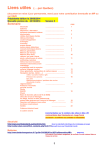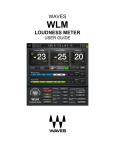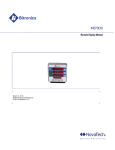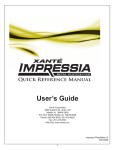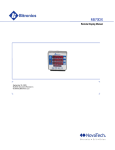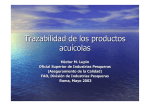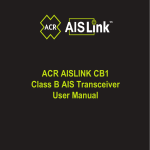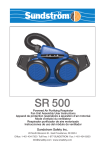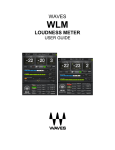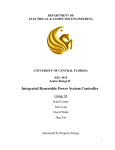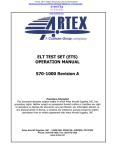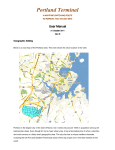Download Search and Rescue Beacon - Maritime Symposium Rotterdam
Transcript
Integration of SART and EPIRB ~ Search And Rescue Beacon (SARB) ~ Theme: improvement and innovation Students: Group 5 Kevin de Bruin Daan van de Vrie Glenn Melis Merlijn Plandsoen [email protected] [email protected] [email protected] [email protected] Project principal: Kluijven, P. van [email protected] Project manager: Drift, M. van der [email protected] Version 3.0 Rotterdam, February 12, 2014 Summary In the modern maritime sector, safety is a part of the daily routine on board vessels. Especially the people in the maritime- and offshore sector come across a lot of safety procedures and measures in their daily work. Many of these safety measures are set by the IMO to prevent any emergency situations. What people need to remember is the fact that in this industry, a small problem can lead to a catastrophic disaster. Every sailor or offshore employee has received training in the use of different safety devices; without the training one cannot work in this sector as stated in by the IMO (2004). There are also regular safety drills, in which they train their emergency procedures. These safety drills are part of the job. In the unlikely event of an emergency situation, for example an uncontrollable fire or a leak below the waterline, and the order for abandoning ship has been given there are luckily different safety devices, which should make survival possible. Two of the mandatory safety devices are the SART, Search And Rescue Transponder, and the EPRIB, Emergency Position-Indicating Radio Beacon. The SART sends a signal which is visible on the radar. The signal is shown as a line of dots straight from the source, representing a bearing and distance to the life raft. This signal is a homing signal. The EPIRB does not have a homing signal for vessels, only for aircraft. However, the EPIRB has other advantages. The EPRIB is able to alert the mainland in a distress situation and provide its position. Multiple devices in an emergency situation can leave a lot of room for error. This raised the question: Why are there two devices, when it could be combined into one to enhance its effectiveness. Because the range of the SART is not that big, only 5 nautical miles, search and rescue teams have developed a searching pattern. To follow this pattern it costs valuable time. Another problem with the SART is that a sailor must take the device with him in the life raft and activate it manually. The main question is: How can the SART and the EPIRB be integrated and their deployment and operation be made more autonomous and effective? To give an answer to this question, a qualitative research method has been used. This means that by using available information an answer is given to the question and problem. Research shows that it is possible to make a device like this, but the market for the product is limited. 2 Preface This project is done as a part of the curriculum to learn more about doing research and valuing the articles that are used in the desk-research phase. The problem in this project is focused on safety and user simplicity for the maritime sector. For a good product the group has to work together to get the best end result. The work was split up in three main categories. Within these categories there are sub-questions. Each member of the group worked out two or more questions by doing desk-research. In the last week of the project phase, the group did a field research. Before reading this report, it’s advised to have some basic knowledge about the safety practices in the maritime world. The project group likes to thank the following persons: Mrs. Van der Drift, for guiding the project and getting a contact person. Mr. Van Kluijven, for the comment on the draft report and suggestions during the project. Mr. Griffioen, for the information and suggestions during the project Mr. Fred Tallaksen, maritime technical support at Jotron, for the interview and additional information provided on the topic. Robin George, marine product manager at McMurdo and Kannad, for the interview and additional information provided on the topic. Rotterdam, February 12, 2014 Merlijn Plandsoen Kevin de Bruin Glenn Melis Daan van de Vrie 3 Contents Introduction............................................................................................................................................. 5 Problem description ................................................................................................................................ 6 Problem definition................................................................................................................................... 6 Main question ......................................................................................................................................... 7 Main objective ......................................................................................................................................... 8 Borders .................................................................................................................................................... 8 IMO-regulations ...................................................................................................................................... 9 The EPIRB............................................................................................................................................... 11 The SART ................................................................................................................................................ 12 The range of the SART ........................................................................................................................... 13 Detection by 10 cm radar ..................................................................................................................... 15 Deployment of the beacon.................................................................................................................... 17 Installation on board vessels ................................................................................................................. 19 Batteries ................................................................................................................................................ 20 Conclusion ............................................................................................................................................. 22 Recommendation .................................................................................................................................. 22 References ............................................................................................................................................. 23 4 Introduction The idea of this project is to combine the SART and the EPRIB. There are several problems that will be addressed in this report. The main goal is to combine the SART and the EPIRB to create a device wherein the advantages of the SART and EPRIB are used. To help structuralize the project we devised a set of sub-questions to formulate an answer on the main-question: -How do regulations affect combining the safety beacons in question? -What is the operating principle of the EPIRB? -What is the operating principle of the SART? -How can the range of the SART be improved? -How can the new safety beacon be detected by 10 cm radar? -How can the new safety beacon best be deployed? -How can the new safety beacon be installed on board vessels? -Which batteries should be used? This project will not include research on the following aspects: Human factor Working prototype Building costs Safety drills The report is built up out of chapters. In every chapter sub-question is answered. In the last chapter the conclusion of the main question will be described. 5 Problem description In the modern maritime sector, safety is a part of the daily routine on board vessels. Especially the people in the maritime- and offshore sector come across a lot of safety procedures and measures in their daily work. Many of these safety measures are set by the IMO to prevent any emergency situations. What people need to remember is the fact that in this industry, a small problem can lead to a catastrophic disaster. Every sailor or offshore employee has received training in the use of different safety devices; without the training one cannot work in this sector as stated in by the IMO (2004). There are also regular safety drills, in which they train their emergency procedures. These safety drills are part of the job. In the unlikely event of an emergency situation, for example an uncontrollable fire or a leak below the waterline, and the order for abandoning ship has been given there are luckily different safety devices, which should make survival possible. One of the safety devices available to sailors in danger is the SART. The ‘Search and rescue Radar Transponder’. This is a very important device, because it displays the location of the survivors on the radar of the Search and Rescue (SAR) party. So the survivors should not forget this beacon, because it doesn’t release automatically when a ship sinks. The device should be held at a height of at least 1 metre. This will use the energy of the sailor in a situation that he needs to spend as little energy as possible. Although, when . When a vessel sinks a hydrostatic release opens and the EPIRB is released from the ship and turned on. EPIRBs are radio beacons that interface with the COSPAS/SARSAT system, and provide the coordinates of its location. EPIRBs do not interface with the INMARSAT system because INMARSAT themselves have terminated support for this service. EPIRBs can also be deployed manually and taken into the life raft. But if it’s deployed by the hydrostatic release, it gives the location of where the sunken ship is, and where the current takes it. But not the location of the survivors. By automating the deployment process and the usage of the SART, the sailors in danger are ridden of an extra burden during an already difficult situation. It should be possible to achieve this with existing materials and technology because it is shown by the working of the EPIRB. There is no system which contains both the SART and EPIRB. Problem definition The deployment and usage of different safety devices is too demanding for a sailor in an emergency situation. 6 Main question How can the SART and the EPIRB be integrated and their deployment and operation be made more autonomous and effective? The main question can be divided in three types of sub-questions: - Integration - Operation - Deployment Sub-questions How do regulations affect combining the safety beacons in question? What is the operating principle of the EPIRB? What is the operating principle of the SART? How can the range of the SART be improved? How can the new safety beacon be detected by 10 cm radar? How can the new safety beacon best be deployed? How can the new safety beacon be installed on board vessels? Which batteries should be used? Type of question Integration Research methodology Desk research Qualitative/ Quantitative Qualitative Type Operation Desk research Qualitative Literature Operation Desk research Qualitative Literature Operation Desk research Qualitative Literature Operation Desk research Qualitative Interview / Literature Deployment Desk and Field research Qualitative Literature / Experiments Deployment Desk and Field research Qualitative/ Quantitative Interviews / Literature Integration Desk research Qualitative Literature 7 Interviews Literature Viking, Ocean signal, McMurdo Viking , Marine trading int. , Alphatron Main objective The main objective of this project is to research a possible implementation of a new device with a better performance than the current safety beacons SART, Search And Rescue Radar Transponder, and the EPIRB, Emergency Position Indicating Radio Beacon. Borders This project will not include research on the following aspects: Human factor Working prototype Building costs Safety drills Human factor There will be no research on the human factor, as this would provide a great deal of research in a field of which this project is not meant to take place. Working prototype It is not one of the objectives of this project to build a working prototype. In addition to the lack of funds the risks of activating fully operational emergency beacons could be confusing and dangerous. Building costs There will be no research into the costs of building the emergency beacon. Since no working prototype will be created, the costs of building such a prototype or the costs of full-scale production are not of interest. Safety drills Safety drills can get a crew prepared for an emergency situation. Although this is important, it has no relevance to the end objective of this project. It will not be researched. 8 IMO-regulations The International Maritime Organization, IMO for short, is the specialized agency of the United Nations with the responsibility for the safety and security of shipping and the prevention of marine pollution by vessels1). This responsibility is carried out through resolutions in which certain regulations are stated and should always be met. The set of safety procedures, types of equipment, and communication protocols used to increase safety and in addition, make it easier to rescue distressed ships, boats and aircraft are stated in the resolutions of the Global Maritime Distress and Safety System (GMDSS). These regulations are agreed-upon internationally. Examples of safety equipment are the SART, Search and Rescue Transponder, and the EPIRB, Emergency Position-Indicating Radio Beacon. In an abandon ship situation, the sailor is obliged to take the SART with him into the lifeboat. The EPIRB, which is mounted on the bridge wing, will be released, and automatically activated, by a hydrostatic release unit as it reaches a certain depth with the sinking ship. The main function of both devices is marking its own position, the possible position of castaways. As both devices have the same main function, it is a logical reasoning that these devices can be easily integrated. The SART and the EPIRB have similarities in performance standards, though there are also a lot of specific performance standards for each device. These specific performance standards must be taken in account, in order to develop a new integrated device. If the regulations of the SART and the EPIRB conflict, these devices cannot be integrated in their existing forms. Digging in the various resolutions of the IMO will give the answer to the question: Is it possible to combine the devices while meeting all present regulations? To answer this question, a qualitative method of research has been used by means of literature. The GMDSS states that the SART and the EPIRB should2)3): - Be fitted with means to prevent inadvertent activation - Be equipped with means which is visible or audible, or both, to indicate correct operation - Be capable of manual activation and deactivation - Be capable of withstanding without damage drops from a height of 20 metres into the water - Be so designed that the electrical portions are watertight to a depth of 10 metres for at least 5 minutes. - Be given consideration to a temperature variation of 45°C during transitions from the mounted position to immersion. - Not be affected in performance by the harmful effects of a marine environment, condensation and water leakage. - Be capable of floating if it is not an integral part of survival craft - Be equipped with buoyant lanyard, suitable for use as a tether, if it is capable of floating - Not be unduly affected by seawater or oil. - Be resistant to deterioration in prolonged exposure to sunlight - Be of a highly visible yellow/orange colour on all surfaces where this will assist detection. - Be designed to be able to operate under ambient temperatures of -20°C to +55. It should not to be damaged in stowage throughout the temperature range of -30°C to +65°C. 1) Description of the IMO, www.IMO.org 9 Specific performance standards for the EPIRB are2): - Be automatically activated after floating free - Be capable of floating upright in calm water and have positive stability and sufficient buoyancy in all sea conditions - Be capable of being tested, without using the satellite system, to determine that the EPIRB is capable of operating properly. - Be provided with a 121.5 MHz beacon primarily for homing by aircraft - The battery should have sufficient capacity to operate the satellite EPIRB for at least 48 hours - Should be designed to be able to operate under icing - Should be designed to be able to operate under relative wind speeds up to 100 knots - Should have local manual activation; remote activation may also be provided from the navigating bridge, while the device is installed in the float-free mounting - Should be capable, while mounted on board, of operating properly over the ranges of shock and vibration and other environmental conditions normally encountered above deck on seagoing ships - Should be designed to release itself and float free before reaching a depth of 4 metres at a list or trim of any angle. Specific performance standards for the SART are3): - Be capable of being easily activated by unskilled personnel - Be provided with an indication of the stand-by condition - Have a smooth external construction to avoid damaging the survival craft - The SART should have sufficient battery capacity to operate in stand-by condition for 96 hours, in addition, following the stand-by period, to provide transponder transmissions for 8 hours when being continuously interrogated with a pulse repetition frequency of 1 kHz. - The height of the installed antenna should be at least 1 metre above sea level - The vertical polar diagram of the antenna and hydrodynamic characteristics of the device should permit the SART to respond to search radars under heavy swell conditions. The polar diagram of the antenna should be substantially omnidirectional in the horizontal plane. Horizontal polarization should be used for transmission and reception. - The SART should operate correctly when interrogated at a distance of up to at least 5 nautical miles by a navigational radar complying with resolutions A.477(XII) and A.222(VII), with an antenna height of 15 metres. It should also operate correctly when interrogated at a distance of up to 30 nautical miles by an airborne radar with at least 10 kW peak output power at a height of 3,000 feet. During the research into the IMO-regulations no restrictions were found which stated one cannot integrate a SART with an EPIRB. As there are no restrictions on integration of safety devices, the IMOregulations do not affect combining the two safety devices in question. Before any vessel may use it in an emergency situation the IMO would have to approve the plan and adopt regulations concerning the new device to the GMDSS. 2)IMO 3) Resolution A.810(19) -- http://www.imo.org/blast/blastDataHelper.asp?data_id=22575&filename=A810(19).pdf IMO Resolution A.802(19) -- http://www.imo.org/blast/blastDataHelper.asp?data_id=22569&filename=A802.pdf 10 The EPIRB In the maritime safety treaty, called the International Convention for the Safety Of Lives At Sea, of the IMO, the required safety equipment on board of vessels is stated. Two devices, the EPIRB and the SART, will be described in this and the following chapter. The reason for separate chapters is because of the fact they are two completely different devices and can’t be compared with each other. This chapter will give an answer to the question: What is an EPIRB and how does it works? To answer this question, a qualitative method of research has been used by means of literature. The Emergency Position-Indicating Radio Beacon, EPIRB for short, is one of the required safety devices. It’s the only device that makes a connection with satellites. The advantage of the satellite connection is that is not limited to range for detection. The satellite connection, made by the EPIRB, is a 6 digits code of the Ship Station Identity Code (part of the Maritime Mobile Service Identity) with in addition, a unique serial code and the call sign of the vessel in distress on the 406 MHz frequency. The distress signal of the EPIRB is received by the COSPAS-SARSAT or the LEOSAR satellites. When the signal is received by the LEOSAR satellites, an emergency signal will be send to the nearest Search and Rescue Centre. The signal to the Search and Rescue Centre only consists of a message that a vessel is in distress. It does not contain a position. The COSPAS-SARSAT uses the Doppler-effect to get a position of the EPIRB. The COSPAS-SARSAT also works in the area of 70° North and 70°South. The disadvantage of the COSPAS-SARSAT is that it takes about two hours to get a relatively good position. The EPRIB sends out two signals. The first signal is the satellite signal, the second signal is a homing signal. The second signal is used for homing by aircraft and search and rescue vessel. To receive the homing signal (121.5 MHz) the vessel/aircraft will have to be fit with a special receiver unit. Without this receiver unit the signal cannot be received. This signal will transmit continuously, but will be interrupted for two seconds for the transmission of the 406 MHz signal. There are two types classes of EPIRBS. The first class is automatically activated by immersion in water and is detectable by COPAS-SARSAT satellite between 70° North and 70° South. The EPRIB can be detected by LEOSAR satellites in the area not covered by the COSPAS-SARSAT. This type is commonly used in merchant shipping. The second class is not of interest for merchant shipping. EPIRBs of this class are so called PLBs, Personal Locating Beacons. PLB’s are commonly used by hikers. The EPIRB must be registered by the NOAA SARSAT, conform the regulations. This information includes contact information of the ship-owner(s). If the EPIRB is not registered by the International Telecommunication Union (ITU), will not contain information that would be given if the EPIRB is registered. 11 The SART In the SOLAS of the IMO the required safety equipment on board of a vessel is stated. Two devices, the EPRIB and the SART, will be described. In the previous chapter the EPIRB has been described. This chapter will give an answer to the question: What is a SART and how does it works? To answer this question, a qualitative method of research has been used by the means of literature. The Search and Rescue Radar Transponder, SART for short, is one of the required safety devices. In an emergency situation the sailor should take the SART with him. The SART should be activated by the sailor. When activated, it can reflect an electromagnetic wave from a radar. the radar transmits electromagnetic waves, which will be reflected by any object within range. After the antenna of the radar is finished transmitting the pulse, control is switched to the receiver. The receiver allows the antenna to receive signals. The reflected signals are being received, and processed. During processing useful information is calculated from the reflected signal, such as the time taken for it to be received. This information is then translated into useful data, such as distance and bearing of the object. The process of sending, receiving and processing occurs about a thousand times a second. When an electromagnetic wave sent from an "X" -band radar (3cm radar) reaches the SART it gets triggered and starts transmitting on a frequency of 9.2 to 9.5 GHz. For each wave the SART receives it sends 12 pulses back, with a small delay between them. Because of this delay the processor of the radar is tricked into “thinking” there are multiple objects behind one another. And thus there are twelve dots in a straight line visible on the radar. The diagrams above show the SART is visible at 5-6 miles, 2-3 miles, and <1 mile. When the radar closes in on a SART, the signal as seen on the radar screen will gradually change from a line of dots to a set of concentric circles. 12 The range of the SART In an emergency situation there are several devices available for a sailor. One of the safety devices which should be available for a sailor in danger is the SART. SART shows the Search And Rescue (SAR) party the exact location of the survivors on the radar. The Global Maritime Distress Safety System (GMDSS) states the required performance standards of the SART. The SART should e.g. be able to reach a range of at least 5 nautical miles when held 1 metre above the waterline and a vessel’s radar height of 15 metres. To reach this range a survivor must hold the SART at this height outside the life raft. Energy spent on this could better be reserved for keeping body heat. This raised the question: How can the range of the SART be improved without survivor interaction? To answer this question, a qualitative method of research is used by the means of literature. In the previous chapter about the SART, the communication between the SART and the radar is explained. When an electromagnetic wave sent from an "X" -band radar (3cm radar) reaches the SART, it gets triggered and starts transmitting on a frequency of 9.2 to 9.5 GHz. For each wave the SART receives it sends 12 pulses back, with a small delay between them. Because of this delay the processor of the radar is tricked into “thinking” there are multiple objects behind one another. The signals are shown as a line of dots straight from the source, representing a bearing and distance. This kind of signal is also known as a homing signal. The search party can utilize this to find their way to the SART. This image shows how an activated SART looks on the radar. When the SART is held 1 metre above sea level, the SART signal will be visible from a distance of 5 nautical miles, assuming the ship’s radar is at a height of 15 metre. This means the radar has a very limited field of view. To improve the chance of survival, the range should be improved to enlarge the visibility. The SART works with a horizontally polarized omnidirectional radar receiver and transmitter. This type of antenna can’t be extended as a regular antenna by means of a metal wire. By raising the SART, the transmitter will be higher above sea level and the range will be greatly improved. To determine the height at which the horizontally polarized omnidirectional radar should be placed, one should determine the desired range and the height of the vessel’s radar. The desired range at which the target should be detected is about 10 nm. 13 The height of the SART’s transmitter can approximated with the following equation4): 𝑟 = √2ℎ𝑣 𝑘𝑟𝑒 + √2ℎ𝑠 𝑘𝑟𝑒 Where in: R= range hv = height of vessel’s radar hs = height of SART’s transmitter kre = effective radius of earth with a standard atmosphere5) R hv hs kre range height of vessel’s radar height of SART’s transmitter effective radius of earth with a standard atmosphere 10 nm = 18520 m 15 m -- m 4 4 x radius earth = 3 𝑥 6378000 m 3 One wants to know the height of the SART transmitter. The equation above can be written as a form of hs : 2 𝑅 ℎ𝑠 = ( ) √2ℎ𝑣 𝑘𝑟𝑒 + √2𝑘𝑟𝑒 2 ℎ𝑠 = 18520 4 4 √2 ∗ 15 ∗ ( ∗ 6378000) + √2 ∗ ( ∗ 6378000) 3 3 ( ) ℎ𝑠 = 0.85 𝑚 The result of the equation is a rough approximated theoretical height where the transmitter can be placed to reach a range of 10 nm. The theoretical height is lower than the mandatory minimum height of 1 metre. The range of an antenna at a height of 1 metre will theoretically be larger than the minimum mandatory range of 5 nm and even bigger than 10 nm. However, to reach a distance of 10 nm the signal should be amplified. Nowadays the strength of the signal is limited by the battery capacity. The SARB will have larger batteries with a higher capacity. Research about the batteries will be described in the chapter ‘Batteries’ at page 20. The practical height should also be higher as the electromagnetic waves interfere with the atmospheric circumstances. 4)5) Syracuse Research Corporation -- http://www.mit.edu/~lrv/cornell/publications/radar%20principles.pdf 14 Detection by 10 cm radar One of the safety devices which are available for a sailor in danger is the SART, the ‘Search And Rescue Radar Transponder’. This is a very important device, because it shows the Search And Rescue (SAR) party the location of the survivors on the radar. The SART works through a receiver, which when hit by a beam from a 3-cm radar, will activate the SART to put out a signal on the 9 GHz-band6). But this raises a question: Why is the signal from the SART only activated and visible on the 3 cm radar and not on the 10 cm radar? To answer this question, a qualitative method of research is used by the means of literature. There are two different types of resolutions that can be used on the radar, the X-band and the Sband. The band is the frequency of the electromagnetic wave the radar transmits. A wave on the Xband is transmitted with a frequency of 9 GHz and a wave length of 3 cm. A wave on the S-band transmits with a frequency of 3 GHz and a wave length of 10 cm. The wave length is commonly used to emphasize which resolution is used on the radar. A big advantage for using the 10 cm radar is that the electromagnetic waves produced by the 10cm radar are less absorbed by rain7). So one will have a clearer radar image7), without having to filter out the rain, as on the 3 cm radar. This way one has a clear image without having the risk of filtering out smaller objects, as buoys, or small ships. A disadvantage of the 10 cm radar is that it is less exact, if compared to an image made by a 3 cm radar. The image made by the 10 cm radar is of a lower definition, which means the edges of obstacles are rougher. At the moment SARTs do not operate on S-band(3 GHz/10 cm) radar, hence one of the aims became: making the SARB compatible with S-band radar. There hasn’t been built a safety beacon which is compatible with the 10cm-radar yet, because not every GMDSS-compliant vessel has a Radar with a S-band, as it isn’t mandatory. This is one of the main reasons for the industry for not building a Sband compatible device. To have the most chance of detection one wants to use the most common type of radar, the X-band radar (9GHz/3 cm). Another reason for the absence of an S-band safety device could be that in order to avoid confusion in times of need it eventually will confuse the sailors. Thus it will be easier to have only one type of beacon. In other words, if no S-band SART is present, no one is at risk of taking the wrong SART. An argument of cost can also be made. Simply put: if one takes twice the SART, one gets twice the cost, because everything that makes up the X-band SART now also has to be able to receive and transmit S-band radar waves. As this cannot be done simultaneously by the same components, you need two of every “band-specific” component. Consequently this would also make the SART nearly twice its current size. 6)Marcom-A, Version 1. (juli 2013) STC-Group. 7) Doviak, R. J.; D. S. Zrnic (1993).Doppler Radar and Weather Observations (2nd ed.). San Diego CA: Academic Press. ISBN 012-221420-X. 15 As of yet no reason has been found explaining why a SART would not be able to be made to work with S-band radar. It appears that the band-specific components need to be replaced to make it able to receive and transmit the electromagnetic waves of the S-band. S-band and X-band radars are often used in conjunction with one another, in master-slave setups they are even visible on the same radar screen. So in conclusion, SARTs can be made detectable by S-band radar, simply by making a S-band compatible with a SART. According to Imtech, this is feasible but the antenna will be larger, thus heavier etc. There are more negatives than positives for building an S-band device. 16 Deployment of the beacon Any safety beacon, be it an automatic or hand-o-matic device, will have two states: stored/not deployed and working/deployed. The stored state will be discussed in the chapter about the installation of the device. The deployed state and the way the device deploys will be described in this chapter. Because of fundamental demands placed on the design of the device, both by law and by physics, some aspects of it are set from the beginning. To ensure proper operation the EPIRB’s antenna, for instance, has to be physically placed above the SART’s antenna. The SART’s antenna on the other hand has to be capable of transmitting a signal that when held up 1 meter above the water surface can be received by a radar scanner mounted at a height of 15 meters above the water surface, at a distance of 5 nautical miles. This is dictated by SOLAS legislation. This poses the question: How can the beacon best be deployed? To answer the question, a qualitative method of research has been used by the means of literature and brainstorming. After a lot of brainstorming a conclusion was reached that the device needs to have a long vertical column to accommodate the antennas and supporting electronics. A problem is posed by the fact that adding wiring between the antennas and the devices will tamper with the effectiveness and/or the emitted signals. Wiring can however be added between the electronics and the batteries, the great advantage herein is that the batteries are by far the heaviest component. And with a little imagination and knowledge of physics this property can be exploited to beneficial extent. Naturally the device should be as compact and streamlined as possible when stored. In addition to space savings this also makes it easier to deploy the device. However, when deployed the device must meet, among others, the aforementioned demands and as such have sufficient antenna height, electrical-energy reserves and buoyancy and stability to remain afloat and upright. The idea is to use a ring-shaped flotation device. And with that the basic layout, heavy at the bottom, wide in the middle and slim near the top end. Like a pear. Or, in technical terms: Batteries below the waterline, lowering the center of gravity, increasing the stability. Floatation-ring, on the waterline, partially submerged, providing buoyancy and stability. A mast protruding approximately 1 metres above the water surface, housing the electronics and antennas. The ring will be inflated by a CO2 cartridge, in the same manner as a life raft is inflated. For obvious reasons the mast will have to be segmented to enable compactness in storage. The idea is to use a combination of a CO2 cartridge and a system of pulleys to erect the mast from its stored position. The pulleys will be used in combination with the battery pack, which will move downward, relative to the source of floatation, as the device deploys, creating movement. This movement, powered by gravity itself, provides a very reliable source of power. Together with the CO2 cartridge this will ensure reliable deployment of the mast. 17 After the battery pack has sunk to its intended depth, the connecting arms will be locked into position, providing rigidity, enabling the weight of the battery pack to act as a stabilizer. By doing it this way, as soon as the unit moves off centre the distance that is created will work together with the weight to create a torque, which will try to get the device back on centre. Also by connecting the outer ends of both extending parts, with pulleys and lines, it will ensure that once these parts have moved into position and their mechanical locks activated, a slight tension is presented, providing it with additional rigidity. The conceptual idea, as it presently exists, lends itself perfectly for integration of additional safety beacons or other means of aiding detection. A strobe light could be fitted to the end of the mast for instance, the mast itself could be made to work as a flair-tube, tied in with the SART. So that when the SART receives a radar signal it triggers the operation of visually perceptible detection aids. If this were to be fully examined and made to work, which is utterly feasible, it would result in a unit that: automatically deploys, stays with the survivors, alerting the coastal stations regardless its position, provides means to home in on the device by use of radar and alerts both the rescuers and rescuees that they are in the vicinity of one another. 18 Installation on board vessels There are different ways of installing the safety beacon on the vessel. It should be researched what the best place of installation is and what the best way to deploy. The technology used in life rafts can be used as guidance. Also a look into the technology of Hydrostatic Release Units (HRU) should prove helpful. The new device to be launched will be a bit bigger than the normal EPIRB or SART, but it should still be able self-deploy. This poses the question: How can the new device best be deployed? To answer this question, a qualitative method of research is used by the means of literature. At the moment the SART is in most cases located on the bridge, and should be taken into the life raft when an emergency occurs. The EPIRB is located on the bridge wings, when the device is submerged, because of the ship sinking, it is released by an HRU. An HRU is a small device that cuts a wire or bolt, and thus releases the attached object, in this case the EPIRB. A spring that is compressed under normal circumstances propels the device away from the vessel as soon as the HRU has been activated. A life raft is always packed in a small container, made of two shells. in case of abandoning ship there are a couple of things one need to do to deploy the raft. Fist one should determine how the raft is deployed, if it is deployed by throwing the container overboard a line, called the painter line ,should be attached to a secure point of the ship. When a force large enough is applied to the painter line, the raft will inflate. If the raft is deployed from a crane, one first have to fasten the lines attached to the shell, to the ship. This is to prevent the shell from falling on top of someone already in the water. Again pulling the painter line will inflate the raft. Under normal conditions the painter line is connected to the bracket of the container. When the vessel sinks, the HRU will release the container from its bracket where after the floatation of container and the tension in the painter line will instigate the inflation. For the deployment of the Search and Rescue Beacon (SARB) the above mentioned ways of deployment can be used. But it should not involve any manual labour, because this project started out on the principal of making it less of an effort to use these devices. To make the SARB easy to use it should be already attached to a life raft, before the life raft is deployed, this way one can make sure that it stays with the raft, and won’t float away. So the best way to deploy the SARB will be in the same way as the life rafts itself, thus in a container. Because it’s in a container, the pole with the equipment won’t extend. The shells of the SARB will be separated in the same way as with the life rafts, thus because of the force the inflatable body of the SARB produces when inflating. The picture shows a life raft container, which also could be used for the SARB. 19 Batteries The manufacturers of SARTs and EPIRBs are free to use the material they want for the batteries. At the moment there are no regulations on the material used in the battery. The regulation in this area is provided by a set of benchmarks, as discussed in the chapter IMOregulations that the device as a whole has to meet. This leads to the question: Which batteries should be used? To answer this question of this chapter, experts has been questioned. There has also been a qualitative research used by the means of literature. A GMDSS EPIRB has to be able to function for 48 hours straight after activation, and its battery should be capable of doing this for 5 years. After 5 years IMO SOLAS requirements state that the battery be replaced during Shore Based Maintenance (SBM). However some states choose to alter these regulations for vessels sailing under their flag. For instance Italy has decreased the SBM interval to 6 years in contrast to Sweden who increased it to 4 years. SOLAS also states that the batteries must be unaffected during storage at temperatures ranging from -35O C to 65O C. And that they be able to operate for 46 hours at temperatures ranging from -25O C to 55O C. It appears that most EPIRB batteries use Lithium as base substance. And that they generally operate on at least 9 volts of charge from new. The battery requirements for the SART are not far off those for the EPIRB. In fact the temperature requirements are exactly the same. However the operational duration requirements do differ. Standard, non-AIS, SART have to be able to remain stand-by for 96 hours, and on top of that be able to transmit for 8 consecutive hours. So even if the device receives an electromagnetic wave of an radar in its final hour stand by, it must be able to start transmitting its signal for 8 straight hours. AIS-SARTs almost copy the requirements of non-AIS SARTs, with the exception that they do not operate on stand-by mode. From the moment that an AIS-SART is activated it starts transmitting its signal for 96 hours. So no additional 8 hours, however one can imagine that 96 hours of transmitting requires more energy than 96 hours of stand-by. SARTs, AIS and non-AIS, commonly use Lithium based batteries. These batteries produce the most stable power and can sustain long periods of discharge. They are relatively expensive and lose the last bit of their charge very rapidly. 20 However, they come in a myriad of chemical cocktails, each with their own capacities. Lithium batteries are also more resistant to low temperature than their Nickel-alloy counterparts. Lithium cells do however share one disadvantage, they can overheat and even explode when improperly ventilated. But as proper ventilation is readily implemented within the current range of safety beacons this is not considered to be a problem. Research is being performed on a new alloy for use in lithium batteries. This includes silver- and vanadium-oxides. However at this time not enough information about the behavior of this exists to make educated statements on its application in safety beacons. The answer therefore to the above posed sub-question remains that lithium-alloy batteries are the most suited for the task. 21 Conclusion The new SARB, Search and Rescue Beacon, will make it easier for the sailor in an emergency situation. At the moment, the sailor must activate the SART hand-o-matic and keep it high in the sky to get a good range. The EPIRB will be activated by a hydrostatic release unit, but will float away from the life raft, because it’s not attached to it. The SARB will be capable to launch automatically when a ship sinks and does not float away from the life raft. During the research into the IMO-regulations no restrictions were found which stated one cannot integrate a SART with an EPIRB. As there are no restrictions on integration of safety devices, the IMOregulations do not affect combining the two safety devices in question. Before any vessel is able to use it, the IMO would have to approve the plan and adopt regulations concerning the SARB. One of the goals of the SARB is making it visible on the S-band radar, this radar works with a frequency of 3 GHz and has a wave length of 10 cm. The advantage of 10 cm waves is the capability to penetrate during bad weather situations, such as rain. To make this possible, the antenna of the SARB must be made bigger. The SARB still should be equipped with an antenna for the 3 cm radar, which has a frequency of 9 GHz and a wave length of 3 cm, because not all vessels have a S-band radar as it is not mandatory. If the antennas are placed at a height of at least 0.85 meters, the wave propagation will the theoretically be at least 10 nm when the signal strength is strong enough. The limiting factor at the moment is the strength of the signal, because of the use of smaller batteries to make the devices lighter and smaller. There is good chance of success of the SARB being used by the shipping industry. The SARB can possibly save more sailors in an emergency as there is not much room for error. The SARB is easy in use as it is self-deployed. The sailor’s focus should be at making it save into the life raft, not with taking an device. The IMO should make the SARB mandatory to rescue more rescuees. However, with implementation of the AIS (Automatic Identification System) in a SART, providing the device a more accurate position, rather than the dotted line on the radar screen produced by the SART. Recommendation It is recommended to do a further research on the SARB to make it a more functional beacon, because a device should save the sailors instead of the sailor should save a device. One has to look at the possibility of integrating support of an AIS SART instead of a normal SART. Secondly one has to do more research on the power usage of the device. Also further research has to be done into the exact dimensions of the device to make it float. This can only successfully be done by doing the above research. 22 References 1. 2. 3. 4. 5. 6. 7. 8. 9. 10. 11. 12. 13. 14. http://www.imo.org/blast/blastDataHelper.asp?data_id=22575 http://www.imo.org/blast/blastDataHelper.asp?data_id=22569 Marcom-A, Version 1. (juli 2013) STC-Group. http://www.mit.edu/~lrv/cornell/publications/radar%20principles.pdf Doviak, R. J.; D. S. Zrnic (1993).Doppler Radar and Weather Observations (2nd ed.). San Diego CA: Academic Press. ISBN 0-12-221420-X A.Dean. (2000). Liferafts for the Fishing Industry. (Seafish Report No. SR533). Consulted at October the 17th 2013, http://www.seafish.org/media/Publications/SR533.pdf Dr. C.J. Brooks. (2006). Life Rafts and Lifeboats: An Overview of Progress to Date. Survival Systems Ltd. Dartmouth, Nova Scotia, Consulted at October the 17th 2013, http://citeseerx.ist.psu.edu/viewdoc/download?rep=rep1&type=pdf&doi=10.1.1.214.69 55 TECHNICAL CHARACTERISTICS FOR SEARCH AND RESCUE RADAR TRANSPONDERS. (1998). Consulted at October the 17th 2013, http://www.itu.int/dms_pubrec/itu-r/rec/m/R-RECM.628-3-199409-S!!PDF-E.pdf PRODUCT SUPPORT MANUAL PathFinder™3 Search and Rescue Transponder. (2012). Consulted at October the 17th 2013, http://www.acrartex.com/media/products/1750/1052012155745/Y1-03-0170J.pdf Kannad Marine. (2012). SAFELINK EPIRB User Manual. Consulted at October the 17th 2013, http://www.kannadmarine.com/downloads/Kannad_Marine_SafeLink_EPIRB_user_man ual.pdf Liferaft HRU installation instructions. (2013). Consulted at October the 17th 2013, http://www.wilhelmsen.com/services/maritime/companies/buss/BUSS_Pressroom/Docu ments/Liferaft%20HRU%20installation%20istructions.pdf http://www.corrosion-doctors.org/PrimBatt/Lithium.htm#available http://www.panasonic.com/industrial/batteries-oem/oem/rechargeablecoin/manganese-lithium.aspx Nautische instrumenten en systemen, Reedijk .D , 5de druk 2012. Smit en Wytze Pictures: 1. SART held up http://www.amelcaramel.net/techsauvetageaerien.php 2. Logo IMO http://www.imo.org/Pages/home.aspx 3. EPIRB http://www.mcmurdomarine.com/epirb 4. SART http://www.mcmurdomarine.com/sart 5. SART on RADAR http://www.sartech.co.uk/products/sarts/frequentlyaskedquestions 6. SART Radar Trace http://upload.wikimedia.org/wikipedia/commons/6/63/SART_radar_trace.svg 7. RADAR http://www.globalsecurity.org/military/systems/ship/systems/an-sps-73.htm 8. Life raft container http://www.fallingpixel.com/products/138/mains/liferaftcntnr1.jpg 9. Battery EPIRB http://www.china-marine-radio.com/product_info/18002016.html 23
























